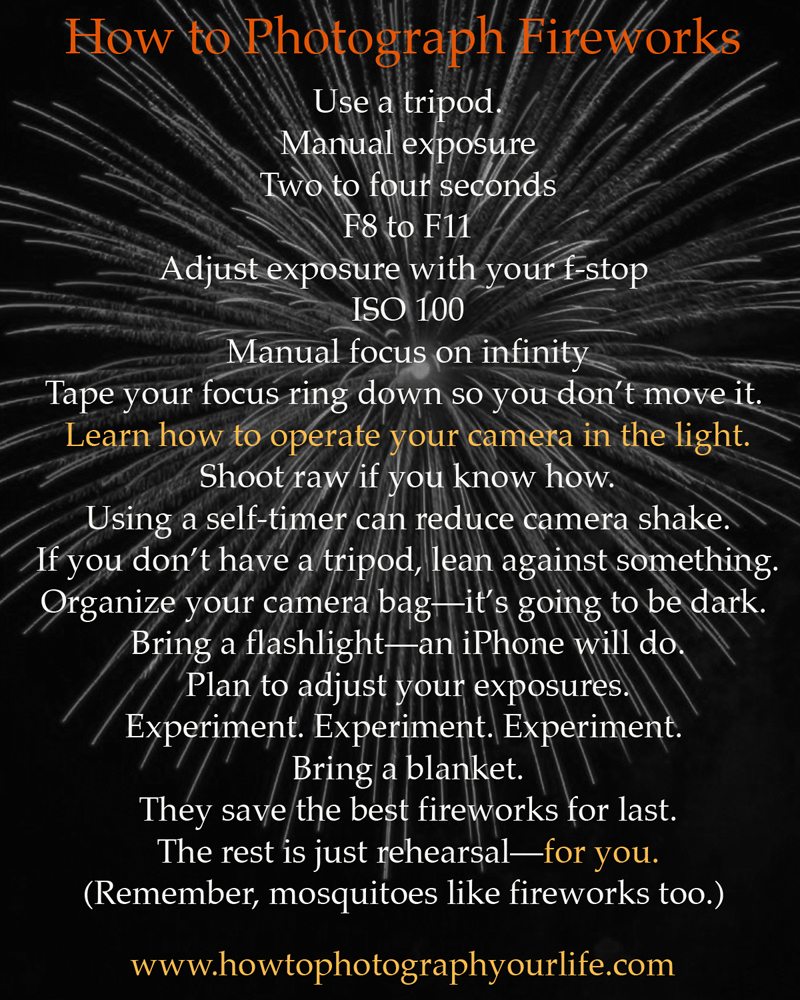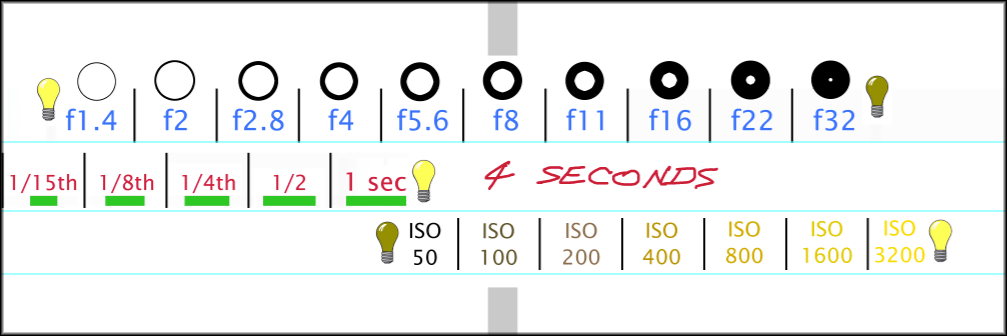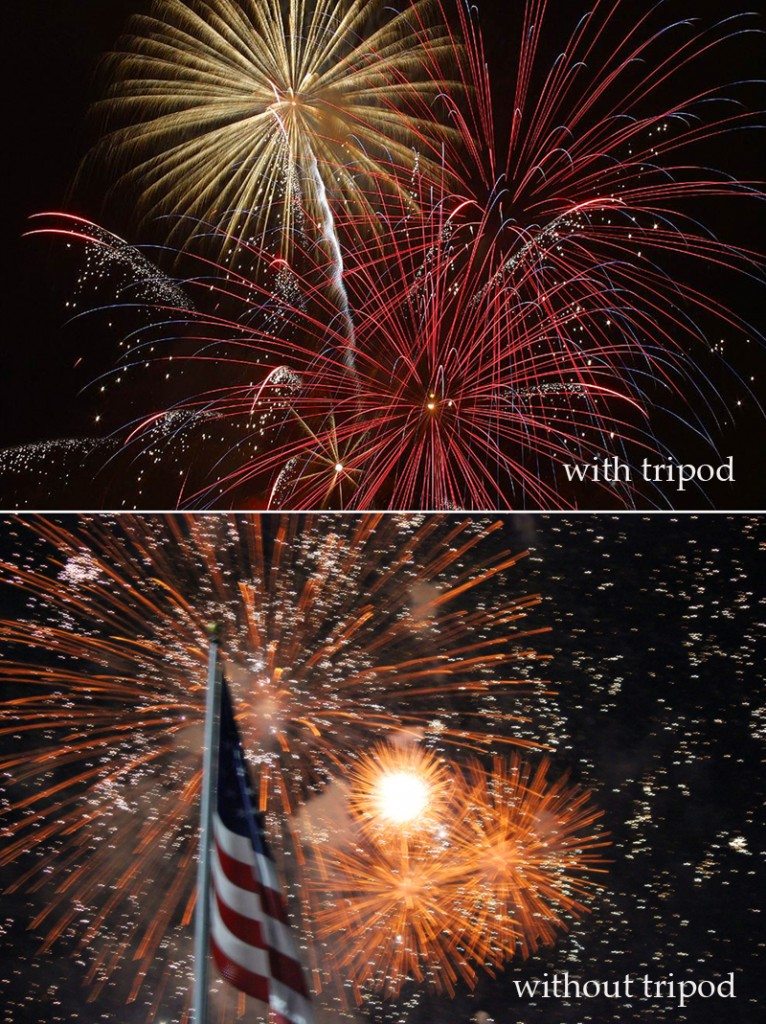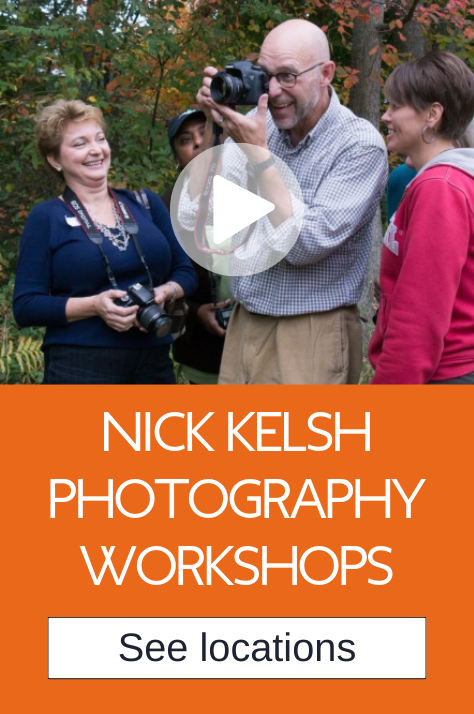A staple of any celebration worth its while is the big fireworks display at the end. If you would like to capture the magic of the night, I’ve compiled some tips for you in this infographic (Hint: share it—your friends will appreciate it!) Plus be sure to read on below for more detailed instructions on capturing fireworks with your DSLR camera. (I also discuss using your camera’s automatic fireworks setting here.)
Photographing fireworks is really fun and, if you’ve never done it, enormously satisfying. For many amateurs it falls into the “Wow, I didn’t know I could do that!” category—well, you can. And fireworks pictures are a wonderful exercise in manual photography—manual focus and manual exposure are the only way to go.
(Don’t tell anyone, but it’s actually not the only way to go … some cameras have a Fireworks setting built right in – I write about that in my blog about “Making the most of your camera’s Fireworks function“)
Here’s the idea. Fireworks are actually very bright and they evolve over time—usually a few seconds. So you want your shutter to be open for a relatively long time—probably 2 to 4 seconds. In the world of photography, that’s a long, long time.
Long shutter speeds and bright subject matter add up to a low ISO number. ISO 100 or 200 should work fine. Yes, you’re shooting in the dark, but the fireworks are really bright. Don’t be fooled into thinking you need a high ISO number.
A long shutter speed means if you want to take tack sharp pictures you’re going to need a tripod. If you don’t use a tripod you’re going to get slightly out-of-focus, mushy images that the impressionist painters would have loved, but I can practically guarantee you will like the sharp tripod versions better. If you don’t have a tripod, there are ways to cheat it a little bit, but it’s an uphill battle. I’ll get to that in a minute.
Perhaps the most important thing you can do is get your act together before it gets dark. At home, get your camera on manual exposure and manual focus. Get comfortable with adjusting your shutter speed and f-stop. You may need to make some adjustments in the dark so the time spent getting comfortable with the lights on will go a long way. Put your shutter speed on 2 seconds for starters. (2 seconds is not to be confused with one-half second.) Put your f-stop on f11. Organize the contents of your camera bag so you can find everything in the dark.
Also at home, burn into your brain how to focus your camera on infinity. Infinity in photography simply means very far away, and I’m hoping that you are very far away from the fireworks. When you are at the actual fireworks display you could focus on a distant streetlight and that would work fine. F11 should give you enough depth-of-field to cover any focusing glitches. Cinematographers have been known to tape down their lens focusing ring so they don’t accidentally re-focus in the heat of battle. It’s not a bad idea. There are plenty of ways to go stupid when you’re fumbling with a camera in the dark. (Use masking tape—it’s easy to remove.)
Bring a flashlight or some other light source. It’s going to come in handy. An iPhone works perfectly. If you use a flashlight it’s not a bad idea to put a small piece of cloth over it so it’s not too bright and won’t annoy other people watching the fireworks. In other words, you want a small subtle light—just enough to check the settings on your camera. Some masking tape over the flashlight will dim it down a lot.
If you’re confidently shooting raw images, this is a great time to do it. Shooting raw helps cover any exposure errors and the pictures will be much more flexible in your editing program later.
Using a tripod in the dark is not without its problems. People have a tendency to trip over the tripod legs in the dark. So keeping the tripod very low is a good idea—the footprint of the tripod is significantly smaller. If you can, having the camera about 3 feet off the ground so that you can operate it while sitting on the ground seems to work best. Every situation is different, but if you get to the site a bit early you should be able to get yourself situated properly. (You won’t regret bringing a blanket to sit on.)
There are two broad categories of fireworks photos. First, there’s the explosions in the sky. And then, there’s explosions in the sky with something else in the picture. Flags, buildings, reflections in water, silhouettes of people, etc., can all add something to fireworks photos, but they require planning—planning for these photographs is everything. If you have a specific picture in mind, you just may need to get their extra, extra early.
If you do decide to shoot some type of overall scene, you may have an opportunity to use the light of exploding fireworks to compose your picture. It can actually get fairly bright on the ground when fireworks are going off and you can take advantage of that.
Experimentation is important at the beginning of the fireworks show and you are likely going to have to make some adjustments— it’s why you brought the flashlight. Let’s say your pictures are too bright. Close the f-stop down. If you’re at F8 go to F11 and so on. Make your adjustments with the f-stop first. Don’t change your shutter speed. 2 to 4 seconds should do everything you want to do.
When you are using shutter speeds that long it’s possible to have annoying camera motion show up in your pictures even if you’re using a tripod. It’s from you pushing the button. Some people recommend using the self-timer built into the camera as a method for releasing the shutter without having to touch the camera. In other words, if you push the shutter button, the shutter is released seconds later. My self-timer has two settings— 10 seconds and 2 seconds. 10 seconds is way too long. It’s too hard to predict what’s going to be happening in the sky 10 seconds from now. 2 seconds is almost ideal, however. When you hear the explosion on the ground of the fireworks being launched pushing the button then may result in perfect timing. Experiment, experiment, experiment.
And for those of you who want to get a bit fancy here’s a technique that works really well. Get a piece of black cardboard or black cloth. Put your shutter on 30 seconds. With the shutter open keep the black cardboard in front of the lens. Then, when there’s something in the sky you like move the cardboard away from the lens and expose the sky for one second. Then, with the shutter still open, but the cardboard back in front of the lens until something else happens. You can actually obtain 4 one second exposures in the span of 30 seconds and gives some great effects. A tripod is absolutely mandatory for this technique. This is also a great way to avoid bumping the camera when you open the shutter.
Don’t forget that at every fireworks display in the world they save the best for last. It’s almost as if everything you photograph up to that point is rehearsal for the big finale. Remember that. The 30 second/black cardboard technique is perfect for the big finale.
And if you don’t have a tripod, use a one-second exposure and hold the camera is still as you possibly can. Sit on the ground and make a tripod out of your arms by resting your elbows on your knees and bracing the camera against your head. This technique is less than perfect— okay, far from perfect— but you will get some pictures that will be fun to look at, for sure. If you have a lawn chair, you can often sit on the ground and rest your camera on the arm of a chair and hold it remarkably still. Remarkably still, yes, but less-than-perfect. There is no competing with a tripod at a fireworks display.
Many cameras have a special setting called “fireworks”. It automatically uses what it thinks is the best shutter speed and f-stop combination. If you are going to use it, check your manual to see how to set it. This may, in fact, be all some of you need. If you need a few pointers about the Fireworks Mode on your camera, read my post on “Making the most of your camera’s Fireworks Function“.
I can guarantee, however, that the most serious fireworks photographers out there are doing this all manually. Perhaps this is the year you will finally be free of the shackles and tyranny of auto-exposure, free to live the photographic life that is the birthright of all men and women.
Let freedom ring in your photos during every celebration!






